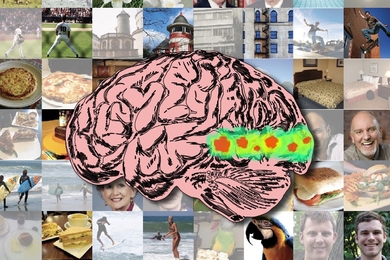More than half of all combat-related injuries sustained by U.S. troops are the result of explosions, and many of those involve injuries to the head. According to the U.S. Department of Defense, about 130,000 U.S. service members deployed in Iraq and Afghanistan have sustained traumatic brain injuries — ranging from concussion to long-term brain damage and death — as a result of an explosion.
Raul Radovitzky, an associate professor in MIT’s Department of Aeronautics and Astronautics, is among the researchers looking at ways to prevent these injuries. In a paper published Monday in the Proceedings of the National Academy of Sciences, he and his colleagues report that adding a face shield to the standard-issue helmet worn by the vast majority of U.S. ground troops could significantly reduce traumatic brain injury, or TBI. The extra protection offered by such a shield is critical, the researchers say, because the face is the main pathway through which pressure waves from an explosion are transmitted to the brain.
In assessing the problem, Radovitzky, who is also the associate director of MIT’s Institute for Soldier Nanotechnologies (ISN), and his research team members recognized that very little was known about how blast waves interact with brain tissue or how protective gear affects the brain’s response to such blasts. So they created computer models to simulate explosions and their effects on brain tissue. The models integrate with unprecedented detail the anatomical features of the head, including the skull, sinuses, cerebrospinal fluid and layers of gray and white matter, as well as the physical characteristics of the blast wave.
“There is a community studying this problem that is in dire need of this technology,” says Radovitzky, who is releasing the computer code for the creation of the models to the public this week (for the code, please e-mail: tbi-modeling@mit.edu). In doing so, he hopes the models will be used to identify ways to mitigate TBI, which has become prominent because advances in protective gear and medicine have meant that more service members are surviving blasts that previously would have been fatal.
Face value
To create the models, Radovitzky and his students collaborated with David Moore, a neurologist at the Defense and Veterans Brain Injury Center at Walter Reed Army Medical Center, who used magnetic resonance imaging to model features of the head. The researchers then added data collected from colleagues’ studies of how the brain tissue of pigs responds to mechanical events, such as shocks. They also included details about the explosion that creates the blast wave upon detonation, including the explosive type, mass and location relative to the target.
The researchers recently used the models to explore one possibility for enhancing the helmet currently worn by most ground troops, which is known as the Advanced Combat Helmet, or ACH: a face shield made of polycarbonate, a type of transparent armor material (the helmets worn by most motorcyclists feature polycarbonate face shields). The researchers compared how the brain would respond to the same blast wave simulated in three scenarios: a head with no helmet, a head wearing the ACH, and a head wearing the ACH with a face shield. In all three simulations, the blast wave struck the person from the front.
Funded by the Joint Improvised Explosive Device Defeat Organization through the Army Research Office and the ISN, the analysis revealed that although the ACH — as currently designed and deployed — slightly delayed the arrival of the blast wave, it didn’t significantly mitigate the wave’s effects on brain tissue. However, in contrast to the results of a previous study, Radovitzky’s team found that the ACH also did not worsen the effects of the blast wave. The models showed a significant reduction in the magnitude of stresses on the brain when a face shield was employed, because the shield impeded direct transmission of blast waves to the face.
“This would be difficult to test in any useful way without using models,” says Joseph Rosen, a professor of surgery at the Dartmouth-Hitchcock Medical Center who was not involved in this research but who chaired a Department of Defense science panel that analyzed the impact of blast injuries on wounded soldiers. While researchers can put instruments inside helmets to test and measure the impact of blasts on the helmets, “what is ultimately important is the impact of the blast on the face, skull and brain,” he says, noting that the models created by Radovitzky’s team help to predict that impact.
The optimal helmet
Rosen believes the models may play a major role in the development of future protective gear not only for the military, but also for researchers studying TBI among the civilian population, as in the case of car crashes and sports injuries. But he cautions that the design of a helmet with a face shield needs more research, including an analysis of how to optimize the design for different parts of the brain. That analysis would then need to be validated with experimental data.
Radovitzky’s team notes that the recent study was limited to a single set of blast characteristics. In future simulations, they will study different kinds of blast conditions, such as those involving different angles and levels of intensity, as well as the impact of blast waves on the neck and torso: It is thought that blast injuries to these areas can indirectly cause brain injury.
Raul Radovitzky, an associate professor in MIT’s Department of Aeronautics and Astronautics, is among the researchers looking at ways to prevent these injuries. In a paper published Monday in the Proceedings of the National Academy of Sciences, he and his colleagues report that adding a face shield to the standard-issue helmet worn by the vast majority of U.S. ground troops could significantly reduce traumatic brain injury, or TBI. The extra protection offered by such a shield is critical, the researchers say, because the face is the main pathway through which pressure waves from an explosion are transmitted to the brain.
In assessing the problem, Radovitzky, who is also the associate director of MIT’s Institute for Soldier Nanotechnologies (ISN), and his research team members recognized that very little was known about how blast waves interact with brain tissue or how protective gear affects the brain’s response to such blasts. So they created computer models to simulate explosions and their effects on brain tissue. The models integrate with unprecedented detail the anatomical features of the head, including the skull, sinuses, cerebrospinal fluid and layers of gray and white matter, as well as the physical characteristics of the blast wave.
“There is a community studying this problem that is in dire need of this technology,” says Radovitzky, who is releasing the computer code for the creation of the models to the public this week (for the code, please e-mail: tbi-modeling@mit.edu). In doing so, he hopes the models will be used to identify ways to mitigate TBI, which has become prominent because advances in protective gear and medicine have meant that more service members are surviving blasts that previously would have been fatal.
Face value
To create the models, Radovitzky and his students collaborated with David Moore, a neurologist at the Defense and Veterans Brain Injury Center at Walter Reed Army Medical Center, who used magnetic resonance imaging to model features of the head. The researchers then added data collected from colleagues’ studies of how the brain tissue of pigs responds to mechanical events, such as shocks. They also included details about the explosion that creates the blast wave upon detonation, including the explosive type, mass and location relative to the target.
The researchers recently used the models to explore one possibility for enhancing the helmet currently worn by most ground troops, which is known as the Advanced Combat Helmet, or ACH: a face shield made of polycarbonate, a type of transparent armor material (the helmets worn by most motorcyclists feature polycarbonate face shields). The researchers compared how the brain would respond to the same blast wave simulated in three scenarios: a head with no helmet, a head wearing the ACH, and a head wearing the ACH with a face shield. In all three simulations, the blast wave struck the person from the front.
Funded by the Joint Improvised Explosive Device Defeat Organization through the Army Research Office and the ISN, the analysis revealed that although the ACH — as currently designed and deployed — slightly delayed the arrival of the blast wave, it didn’t significantly mitigate the wave’s effects on brain tissue. However, in contrast to the results of a previous study, Radovitzky’s team found that the ACH also did not worsen the effects of the blast wave. The models showed a significant reduction in the magnitude of stresses on the brain when a face shield was employed, because the shield impeded direct transmission of blast waves to the face.
“This would be difficult to test in any useful way without using models,” says Joseph Rosen, a professor of surgery at the Dartmouth-Hitchcock Medical Center who was not involved in this research but who chaired a Department of Defense science panel that analyzed the impact of blast injuries on wounded soldiers. While researchers can put instruments inside helmets to test and measure the impact of blasts on the helmets, “what is ultimately important is the impact of the blast on the face, skull and brain,” he says, noting that the models created by Radovitzky’s team help to predict that impact.
The optimal helmet
Rosen believes the models may play a major role in the development of future protective gear not only for the military, but also for researchers studying TBI among the civilian population, as in the case of car crashes and sports injuries. But he cautions that the design of a helmet with a face shield needs more research, including an analysis of how to optimize the design for different parts of the brain. That analysis would then need to be validated with experimental data.
Radovitzky’s team notes that the recent study was limited to a single set of blast characteristics. In future simulations, they will study different kinds of blast conditions, such as those involving different angles and levels of intensity, as well as the impact of blast waves on the neck and torso: It is thought that blast injuries to these areas can indirectly cause brain injury.







